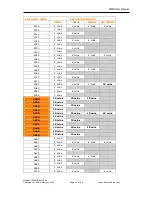
WESII User Manual
Manual-WESII-Rev1205A
Copyright © KBC Networks 2012
Page 43 of 48
www.kbcnetworks.com
6.3
Industry Canada Restrictions
IC ID# 7849A-N523ESD
This device is in compliance with the applicable sections of the Industry Canada RSS-
210 Spectrum Management and Telecommunications Radio Standard Specification
that governs Low Power License-Exempt Radio communication devices. Specifically,
the output EIRP of this device relative to antenna gain is factory set to ensure
compliance with section 6.2.2(q1)(iv)(g).
In addition, it is noted for all users that high power radars are allocated as primary
users (meaning they have priority) of the 5250-5350 MHz and 5650-5850 MHz
frequency bands and these radars could cause interference and/or damage to LELAN
devices such as are covered by this manual.
6.4
CE Regulatory Statement
Class B ITE:
This is a Class B product. In a domestic environment this product may cause radio
interference in which case the user may be required to take adequate measures.
Declaration of Conformity:
KBC declares the following:
Product Name: WESII
Model No.: 802.11n Station conforms to the following Product Standards:
This device complies with the Electromagnetic Compatibility Directive (89/336/EEC)
issued by the Commission of the European Community. Compliance with this directive
implies conformity to the following European Norms (in brackets are the equivalent
international standards.)
Electromagnetic Interference (Conduction and Radiation): EN 55022 (CISPR 22)
Electromagnetic Immunity: EN 55024 (IEC61000-4-2, 3, 4, 5, 6, 8, 11)
Low Voltage Directive: EN 60 950: 1992+A1: 1993+A2: 1993+A3: 1995+A4:
1996+A11: 1997.
CE Mark: following the provisions of the EC directive.
KBC also declares that:
The wireless card in this product complies with the R&TTE Directive (1999/5/EC)
issued by the Commission of the European Community. Compliance with this directive
implies conformity to the following:
EMC Standards: CE: EN 300 328-2, EN 300 826 (EN 301 489-17) EN 301 893.
Dynamic Frequency Selection (DFS) & Transmit Power Control (TPC):
DFS and TPC are requirements of the ETSI standard EN301 893 V1.5.1, the European
Union’s harmonized radio standard for unlicensed devices operating in the 5150 –
5350 MHz and 5470 – 5725 MHz frequency bands. Radar detection is required when
operating on channels whose nominal bandwidth falls partly or completely within the
frequency ranges 5250 MHz to 5350 MHz or 5470 MHz to 5725 MHz. In addition
devices using the 5600 – 5650 MHz band are subject to a 10 minute Channel
Availability Check (CAC). The following table shows how this can affect connection
times for certain frequencies:






































